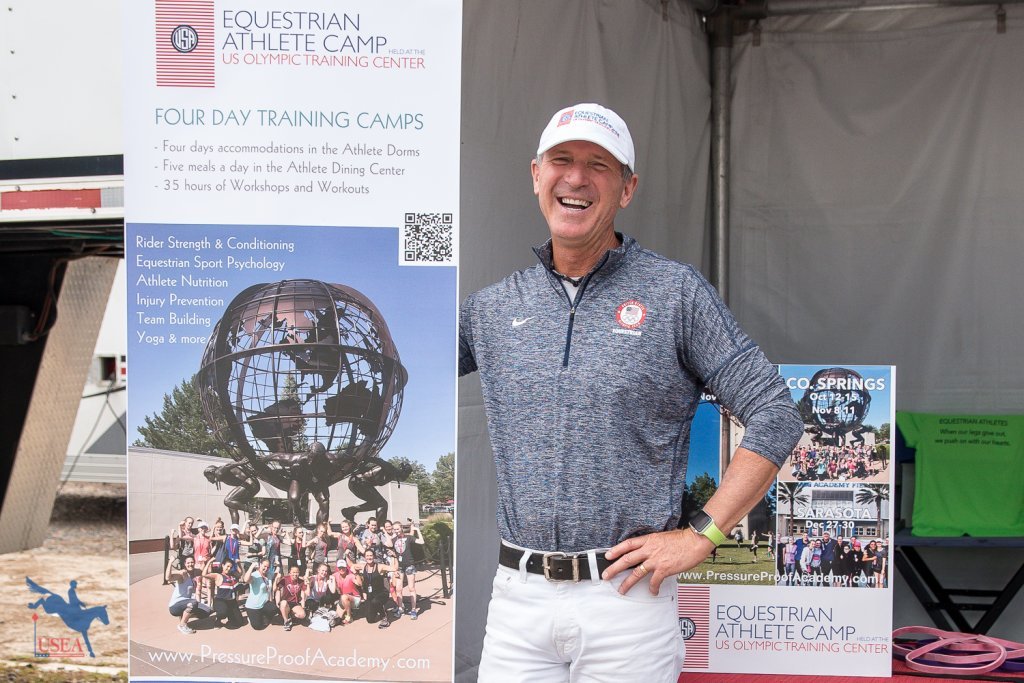Daniel Stewart's Tip of the Month: PRACTICE Like an Athlete

Riding is a sport of distances. We have 12-foot strides, three-foot fences, and 500 meter-per-minute speeds, but perhaps the most important distances of all are the five feet below your ears (because that’s where your strength, stamina, suppleness, and symmetry are built) and the five inches between them (because that’s where your confidence, courage, concentration, and cheerfulness are created.) Without these distances, all the others just aren’t going to to be very much fun.
If you - or anyone you know - has ever attended one of my Equestrian Athlete Training Camps held at the U.S. Olympic Training Centers in Colorado Springs or Lake Placid, you know that I train equestrians to PRACTICE like athletes. Practice like an athlete by engaging in a consistent fitness program and act like an athlete by eating healthy and focusing on the positive. Together these habits keep us safe and successful and prove to our horse that we’d never ask of them what we’re not prepared to ask of ourselves.
While you probably agree that it’s a good idea to PRACTICE like an athlete, you might also wonder how you’re going to find the time and effort to fit all that good stuff into your already crazy-busy life! When a 26 hour day isn’t an option (which would actually be a really good idea) the answer you’re looking for might just come in the form of two simple words: Transfer Effect.

The transfer effect is a phenomenon that occurs when improving one area of your life automatically triggers a desire for improvements in another, meaning that a little daily exercise can trigger your desire to eat healthier; and eating healthier can trigger your mind to become more positive. In the end, making the single effort to practice like an athlete by adding a little fitness to your riding program can also make you act like an athlete by eating healthier and being more confident without even trying. It’s kind of like a BOGO sale for riders - get a little exercise and you get the healthy eating and confidence for free!
And as if this wasn’t enough, the better you get at exercising, the more likely you’re going want more of it, meaning that healthy eating and positive thinking will become more of a healthy habit instead of an effort! You can even shift the pieces around and it’ll still work. Begin by eating healthier and don’t be surprised if you’ll want to start exercising a bit more (and both will make you more positive!) This is called the fitness feedback loop and works thanks to the release of endorphins and the feel-good hormone dopamine that fire the pleasure center in your brain, making you want more of it!
So, this month as you prepare for your inevitable upcoming New Year's resolution, find a way to PRACTICE like an athlete. Studies show that you don’t need to dedicate a lot of time to it - even fifteen minutes of active fitness has been proven to improve your mood and healthy eating habits for up to twelve hours (longer than antidepressants!) Also, don’t forget that as you get older you’ll begin losing your stores of dopamine, so seeking out fitness at least three times a week (in addition to riding) is a great way to keep that fitness feedback loop working!
BONUS
Here are some simple tips to help make exercise and healthy eating a daily part of your life. Remember: fitness won’t just give you a whole new look, it’ll give you a whole new outlook!
Nutrition Tips
- Fruits - Give your body time to burn-off the sugars found in fruits by eating them before 3:00 p.m.
- Meats - The fewer the legs the better! Poultry is better than beef and pork, and fish is better than poultry.
- Veggies - The darker the color (i.e. kale and spinach) the fewer carbohydrates and more fiber they have.
- Grains - Whole grains are better than enriched, and sprouted grains are better than whole grains.
- Dairy - Watch the calories. Some yogurts, flavored milk, and cheeses have as many calories as a Coke!
- Sugars - Beware of hidden sugars in tricky foods like ketchup, BBQ sauce, sports drinks, and juices.
- Color - Except for blueberries, void anything blue! Most are that way because of chemical colorants!
Fitness Tips
- Exercise with a partner who can provide that little extra motivation when you’re not in the mood.
- Make your fitness sessions predictable by scheduling them for the same day and time each week.
- Make fitness fit your life by writing your sessions into your calendar like all other important meetings.
- Pump it up with music! It can lower the perception of pain by 20 percent!
- When you’re really not in the mood, just exercise for five minutes. The endorphin rush you’ll get after that will likely convince you to keep going!
- Prepare to have fun. Exercise because you love your body, not because you hate it!

I hope you enjoyed this month’s tip! If you did, please join my Equestrian Fitness & Focus workshop at the USEA Annual Meeting & Convention in New Orleans on Saturday, December 8 at 8:00 a.m. Also, please consider signing up for one of my upcoming Equestrian Athlete Training Camps held at the U.S. Olympic Training Center in Colorado Springs or Lake Placid, where we’ll spend four days discussing rider fitness, healthy nutrition, yoga, injury prevention/recovery, and much more. Riders of all levels and disciplines are welcome and members of the USEA receive a $255 scholarship.Click here for more information














